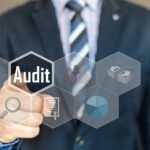Originally published COLUMN: Revolutionizing Public Auditing: Emerging Trends in Transparency and Technology on by https://www.hstoday.us/featured/column-revolutionizing-public-auditing-emerging-trends-in-transparency-and-technology/?utm_source=rss&utm_medium=rss&utm_campaign=column-revolutionizing-public-auditing-emerging-trends-in-transparency-and-technology at Homeland Security
The field of public auditing could undergo a significant transformation as new technologies emerge to reshape how audits are conducted and presented. These innovations are not only increasing transparency but also driving competition, as traditional auditing firms face challenges from non-traditional players. Below, we explore five potential trends poised to redefine the landscape of government audits.
- Rising Public Trust in Blockchain-Based Audits:
Public trust in blockchain-based auditing methods is steadily growing, as blockchain’s transparency, immutability, and decentralized structure make fraud or manipulation far more difficult. In contrast to traditional government audits, which can sometimes face scrutiny for perceived conflicts of interest, blockchain provides an open, verifiable ledger of transactions that cannot be altered once recorded. Auditing companies would be wise to begin integrating blockchain technologies into their processes. As public demand for more transparent and secure oversight increases, governments may find themselves under pressure to adopt blockchain audits as a standard practice. Early adopters in the auditing industry could become leaders in offering tamper-proof solutions that revamp how audits are conducted and validated. - Use of Digital Twins for Public Infrastructure Audits:
Digital twins, virtual replicas of physical infrastructure, are also making their way into the auditing process. By creating real-time digital models of infrastructure such as roads, bridges, and utilities, auditors can simulate different scenarios and assess whether physical conditions align with reported data. This technology-driven approach offers unprecedented accuracy in identifying discrepancies between what is recorded and what exists in reality. Auditing firms that begin leveraging digital twin technology will position themselves at the forefront of the market, providing clients with more precise infrastructure assessments, which could lead to improved decision-making regarding repairs, upgrades, and budget planning. - Global Digital Standard for Government Audits:
On a global scale, the development of a digital standard for government audits, incorporating AI, blockchain, and cloud computing, is on the horizon. This global standard would aim to improve consistency and transparency across countries, potentially driven by international bodies such as the UN or World Bank. For auditing firms, this represents a significant shift. Those that adapt quickly by developing tools to align with the forthcoming digital audit frameworks will be well-positioned for international contracts, particularly in cross-border public projects. Firms that fail to keep up with these new global benchmarks risk falling behind as the auditing industry undergoes a technological transformation. - Increased Competition from Non-Traditional Auditors:
Another emerging trend is increased competition from non-traditional entities, such as tech firms and consultancy groups, which are entering the public auditing space. These new players are leveraging data analytics and AI-driven processes to offer faster, more transparent audits, challenging traditional firms to innovate. To stay competitive, traditional auditing firms will need to enhance their technological capabilities and consider forming partnerships with tech companies. Providing audits enhanced by real-time data analytics and AI-driven insights will allow them to remain relevant and offer innovative solutions that appeal to government clients seeking efficiency and precision. - Supply Chain Transparency for Green Procurement:
Supply chain transparency in public procurement, particularly concerning environmental standards, is gaining traction. Governments are increasingly demanding that their suppliers meet strict environmental compliance standards, especially for large-scale infrastructure projects. Auditing firms are being tasked with verifying these claims, and those that invest in technologies to track and validate green procurement practices will find themselves in high demand. This trend presents a significant opportunity for auditors to support governments in implementing sustainable initiatives while ensuring that public funds are used responsibly.
These emerging trends reflect a broader shift toward increased transparency, efficiency, and technological integration in the auditing process. The traditional landscape of public audits is poised for disruption, and those who embrace these innovations will lead the future of government auditing.
The post COLUMN: Revolutionizing Public Auditing: Emerging Trends in Transparency and Technology appeared first on HSToday.
Originally published COLUMN: Revolutionizing Public Auditing: Emerging Trends in Transparency and Technology on by https://www.hstoday.us/featured/column-revolutionizing-public-auditing-emerging-trends-in-transparency-and-technology/?utm_source=rss&utm_medium=rss&utm_campaign=column-revolutionizing-public-auditing-emerging-trends-in-transparency-and-technology at Homeland Security
Originally published Homeland Security


